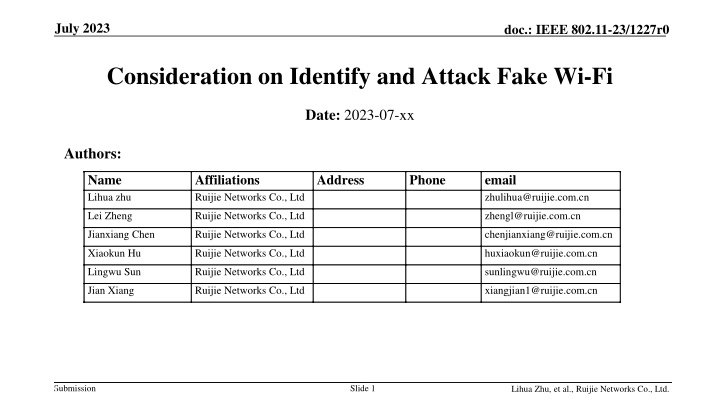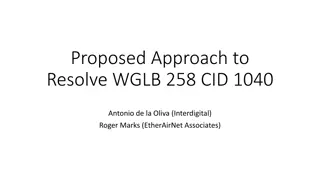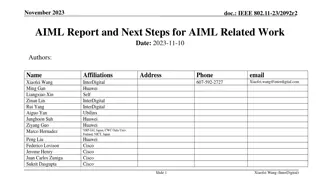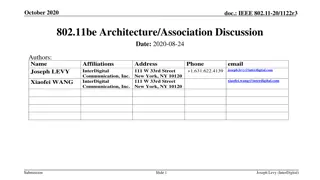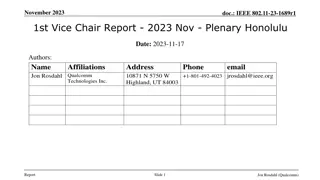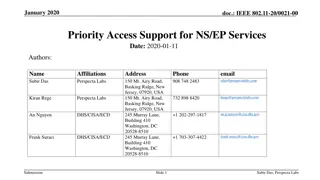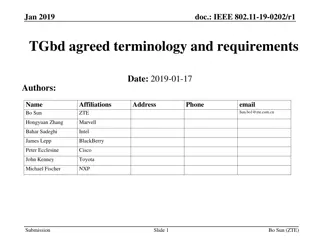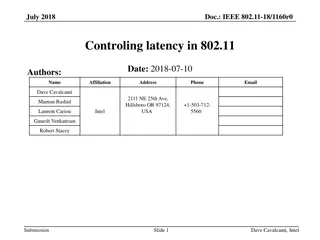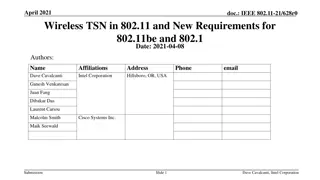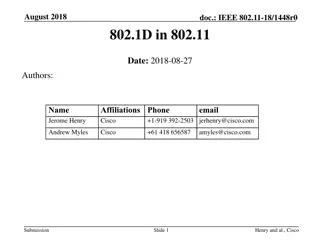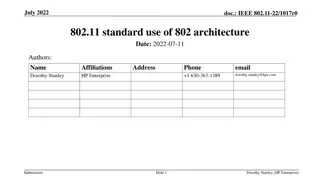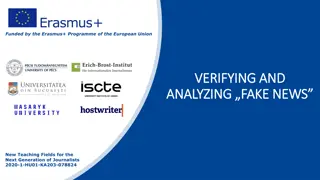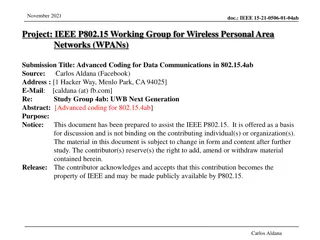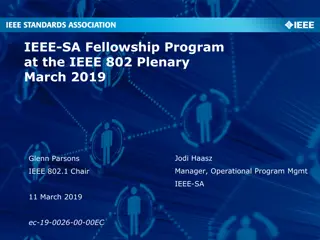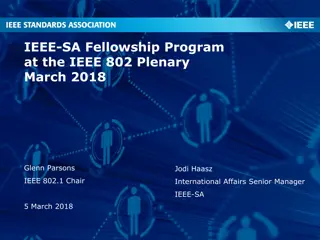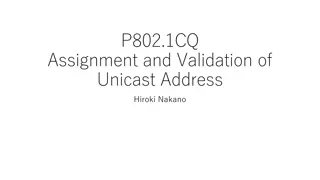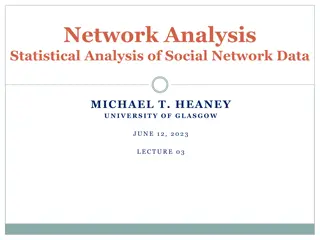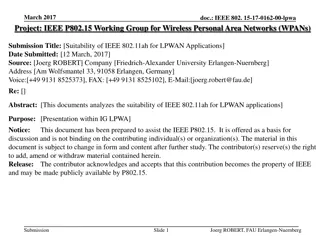Addressing Fake Wi-Fi Networks in IEEE 802.11-23/1227r0
This document explores the threat of fake Wi-Fi networks, the common places where they are found, and the potential risks associated with connecting to them. It discusses the importance of identifying and combating fake Wi-Fi for user privacy and proposes a solution involving hashed SSIDs to prevent the establishment of fake access points.
Download Presentation

Please find below an Image/Link to download the presentation.
The content on the website is provided AS IS for your information and personal use only. It may not be sold, licensed, or shared on other websites without obtaining consent from the author.If you encounter any issues during the download, it is possible that the publisher has removed the file from their server.
You are allowed to download the files provided on this website for personal or commercial use, subject to the condition that they are used lawfully. All files are the property of their respective owners.
The content on the website is provided AS IS for your information and personal use only. It may not be sold, licensed, or shared on other websites without obtaining consent from the author.
E N D
Presentation Transcript
July 2023 doc.: IEEE 802.11-23/1227r0 Consideration on Identify and Attack Fake Wi-Fi Date: 2023-07-xx Authors: Name Lihua zhu Affiliations Ruijie Networks Co., Ltd Address Phone email zhulihua@ruijie.com.cn Lei Zheng Ruijie Networks Co., Ltd zhengl@ruijie.com.cn Jianxiang Chen Ruijie Networks Co., Ltd chenjianxiang@ruijie.com.cn Xiaokun Hu Ruijie Networks Co., Ltd huxiaokun@ruijie.com.cn Lingwu Sun Ruijie Networks Co., Ltd sunlingwu@ruijie.com.cn Jian Xiang Ruijie Networks Co., Ltd xiangjian1@ruijie.com.cn Submission L Slide 1 Lihua Zhu, et al., Ruijie Networks Co., Ltd.
July 2023 doc.: IEEE 802.11-23/1227r0 Background Scope of P802.11bi: This amendment specifies modifications to the IEEE Std 802.11 medium access control (MAC) specification to specify new mechanisms that address and improve user privacy. Fake Wi-Fi: Fake Wi-Fi refers to unauthorized or maliciously created wireless networks that mimic legitimate Wi-Fi networks. These networks are set up by attackers with the intention of deceiving users into connecting to them, often with the aim of stealing sensitive information or conducting other malicious activities. Submission L Slide 2 Lihua Zhu, et al., Ruijie Networks Co., Ltd.
July 2023 doc.: IEEE 802.11-23/1227r0 Background Since, it easy and cheap for attackers to create a fake Wi-Fi network. Fake Wi-Fi networks are ubiquitous. Public Places: Airports, train stations, bus stations, cafes, restaurants, shopping malls, and public parks are common hotspots for fake Wi-Fi networks. Hotels and Accommodation: Fake Wi-Fi networks are often found in hotels, guesthouses, and other accommodation facilities. Attackers take advantage of travelers who expect to find Wi-Fi access in their accommodations. Tourist Attractions: Popular tourist destinations, such as museums, historical sites, and theme parks, may have fake Wi-Fi networks set up to target unsuspecting tourists. Public Transportation: large events, conferences, trade shows, and exhibitions. Attendees may unknowingly connect to these networks while seeking internet access. Submission L Slide 3 Lihua Zhu, et al., Ruijie Networks Co., Ltd.
July 2023 doc.: IEEE 802.11-23/1227r0 Background Especially, in financial institutions such as bank, by capturing personal and financial information through fake Wi-Fi, attackers can impersonate users, open fraudulent accounts, and engage in identity theft. This can lead to significant financial and reputational damage. So how to identify and attack fake Wi-Fi is important for improving user privacy. But it seems nothing about this issue have been discussed in TGbi[1] Submission L Slide 4 Lihua Zhu, et al., Ruijie Networks Co., Ltd.
July 2023 doc.: IEEE 802.11-23/1227r0 Possible solution [2] proposed hashed SSID, AP computes a hashed SSID value and places it in the SSID field of the SSID element. STA computes a hashed SSID value one each SSID that it has been configured with. If there is a match that means this AP belongs to the configured SSID that the non-AP STA could connect to if it chooses to. This submission give us a good idea to prevent the establishment of fake AP, for it is difficult to guess SSID in this case. So we can design mechanism to make SSID not unique or obfuscate SSID in the air. Submission L Slide 5 Lihua Zhu, et al., Ruijie Networks Co., Ltd.
July 2023 doc.: IEEE 802.11-23/1227r0 Possible solution What can do to identify fake Wi-Fi? a. A legitimate AP can listen to Beacon frames from other APs, compare the SSID to its own, and if they match, report the MAC address of the suspected unauthorized AP to the user. The user can then make a decision on how to counteract if necessary. Submission L Slide 6 Lihua Zhu, et al., Ruijie Networks Co., Ltd.
July 2023 doc.: IEEE 802.11-23/1227r0 Possible solution What can do to attack fake Wi-Fi? a. After identify the fake Wi-Fi, legitimate AP should send jamming frames to disrupt the normal operation of Wi-Fi. So TGbi can consider what jamming frames should be like. Submission L Slide 7 Lihua Zhu, et al., Ruijie Networks Co., Ltd.
November 2022 doc.: IEEE 802.11-23/1227r0 Summary The privacy implications of fake Wi-Fi that intrudes upon user privacy should be taken seriously. This submission provide some ideas to solve this issue. Candidate solutions shall be studied and discussed. Submission L Slide 8 Lihua Zhu, et al., Ruijie Networks Co., Ltd.
November 2022 doc.: IEEE 802.11-23/1227r0 References [1] 11-23-0892-00-00bi-requirements-and-issues-tracking, May 2023 [2] 11-22-1383-00-00bi-hashed-ssid, August 2022 Submission L Slide 9 Lihua Zhu, et al., Ruijie Networks Co., Ltd.
